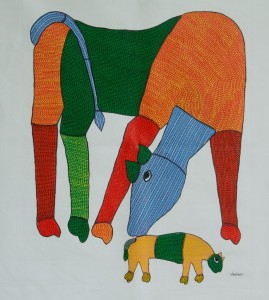GOND PAINTING
Place of origin: Madhya Pradesh and its surrounding states.
Earliest Recorded History – though no textual record exists, the origin of the art form can be traced back to Pre- Aryan era
Genre: Art, Tribal. Traditionally on walls and floors of homes. Now on a variety of modern media, including acrylic paintings on canvas, ink drawings on paper, silkscreen prints, and even animated film.
Geographical Spread :
The Gond territory extended from the Godavari in the south to the Vindhyas in the north. This art form is popular among most tribes in Madhya Pradesh and it is particularly well developed as an art among the Gond tribe of Mandala District.
Technique:
The artist makes a rough paper outline on his/her chosen medium. Geometric patterns, animals, human figures and flowers patterns, local deities, cock fights, forest scenes, agriculture, weddings and scenes fro local folklore are common images in Gond Art. They are often formed of interesting circles and spirals. These are sometimes enhanced with alternate triangles. The artist makes sure to draw the inner as well as outer lines with as much care as possible so that the perfection of the lines has an immediate effect on the viewer. Lines are used in such a way that it conveys a sense of movement to the still images. Dots and dashes are added to impart a greater sense of movement and increase the amount of detail.
Bright colours, such as white, red, blue and yellow are first filled in. The paints are usually derived naturally from objects such as charcoal, coloured soil, plant sap, leaves and even cow dung. More specifically, yellow from Chui mitti which is a type of local sand, brown from Gheru mitti which is another type of sand, green is readily procured from leaves while the colour red is obtained from the Hibiscus flower.
Once the bright colours have been filled into the larger forms drawn on the canvas or paper, small ‘signature pattern’ motifs evocative of tattoos or elements of nature are drawn or ‘infilled’.
Rich in detail, colour, mystery and humour, these tribal artworks brilliantly employ modern means to evoke the pre-modern psyche.
Some Unique Characteristics of Gond Art:
1. The subject of these paintings are extends from myths and folklores to images of daily life – not only from what exists but also much that is drawn from dreams, memory and imagination. Local deities, cockfights, forest scenes, agriculture, weddings and other visuals find a significant place in Gond tribal art.
- The traditional motifs usually carry a special significance. For example, a fish stands for fertility and the Tortoise for stability.
- These paintings have a basic simplicity. They appear without anatomical details, and move in silhouettes. A simple impression of a pair of wings turns gradually into a geometric figure. A fish is symbolized by bones and a tortoise by its flippers.
- Colours too have a symbolic significance. Designs in white or red wash on the floor ensure security of the house.
- These artists work with inherited conventions and so each artist brings something unique and individual to this expression of shared heritage.
- One of the distinctive elements is the use of ‘signature patterns’ that is used to ‘infill’ the larger forms on the canvas. These infill patterns are distinctive identifying marks used by the Gond artists and every Pardhan Gond painter has developed his or her own signature style.
- Numerous Gods and Goddesses, strange and exotic birds, flying snakes,tigers, dogs and cattle, breathtakingly beautiful trees and several other entities who inhabited the age old songs of the Pardhans – these are just some of the wonderful and fabulous subject matters of Gond art. What is amazing is that all of these originally existed as notes and lyrics and nuances of their story telling musical traditions, and have gradually evolved and manifested on the canvas in vibrant colors and in an inimitable, distinctive style.


